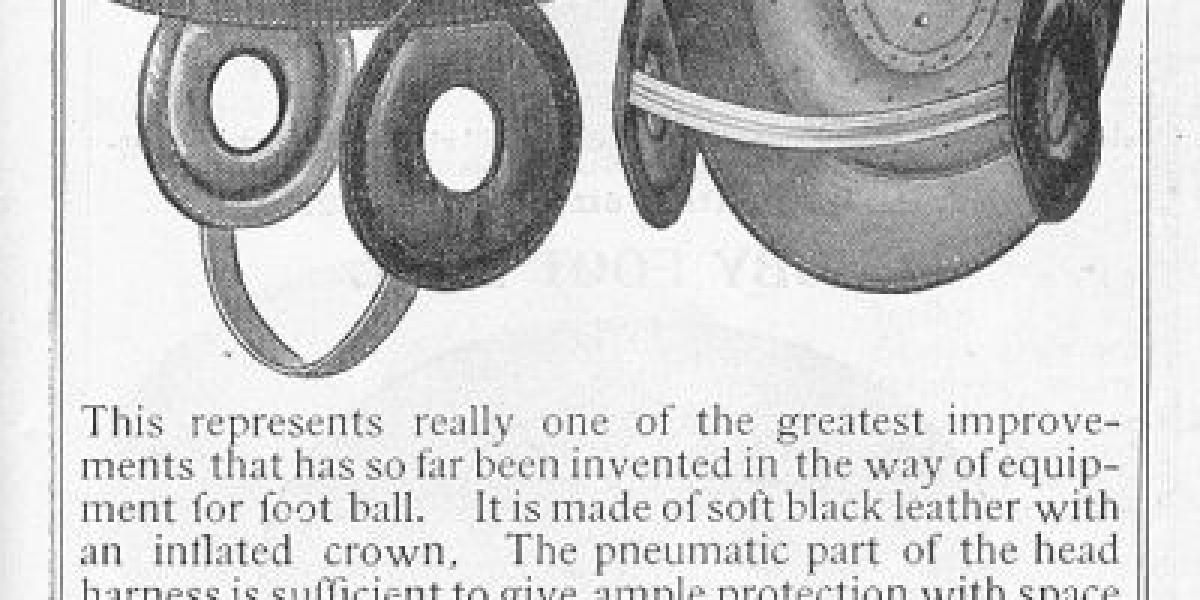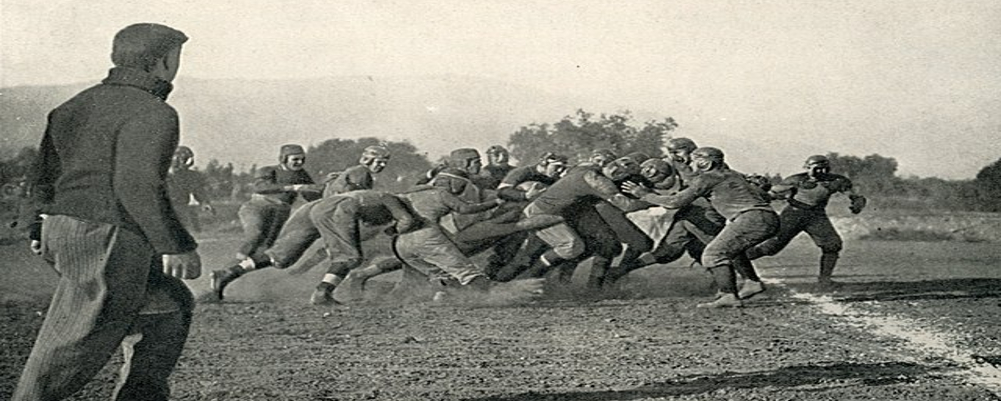Timothy P Brown has a geat post on this on Football Archaeology titled: Getting Pumped Up for Pneumatic Football Pads.
The story of air-filled helmets has an early tie to 1903 with a full-page ad for “Spalding’s Pneumatic Head Harness in Spalding's sponsored Football Rules Guide for that year.
Initially, the idea seemed revolutionary. Pneumatic pads boasted impressive shock absorption, reducing the thud of tackles and promising a new era of player safety. However, problems surfaced quickly. The cumbersome air bladders restricted movement, turning agile athletes into clunky robots. Leaks were frequent, leaving players feeling vulnerable and, ironically, deflated. The technology proved impractical, and by the 1940s, air had all but vanished from the playing field.
Despite their short-lived tenure, pneumatic pads hold a significant place in football history. They represent a bold, if misguided, attempt to address player safety, paving the way for future innovations like leather and foam padding.
Their comical appearance remains a quirky footnote in the sport's evolving narrative, reminding us that the quest for protection is often a bumpy, deflated one.
Transcribed Conversation of Pumped Up Pneumatic Jel with Timothy Brown
Hello, my football friends; this is Darin Hayes of PigskinDispatch.com. Welcome once again to The Pig Pen, your portal to positive football history. And welcome to another edition where we get to talk to Timothy P. Brown of FootballArcheology.com about football from yesteryear and one of the famous tidbits that he's had out recently. Tim, welcome back to The Pig Pen.
Darin, thank you. Looking forward to chatting and getting pumped up. Yeah, like the old Saturday Live skit where they say, we're going to pump you up.
My worst German accent there. So I apologize for that. But yeah, your title is very fitting.
We're saying that because the title of your tidbit from back in August of this past year is getting pumped up for pneumatic football pads. A lot of P words in there, a lot of big words, and a lot of exciting stuff for equipment. So maybe you could tell us a little bit about that story.
Yeah, so this is one of those stories. Last week, we talked about what might have been with St. Louis U football, you know, had they continued playing or if things had gone differently back in the day. So this is kind of similar, but it's one of those things where for, I mean, this happens in all kinds of different product areas and industries, but you know, you kind of have to have this confluence of technology and inventiveness and engineering and manufacturing prowess and everything in order for a product to be successful. And so this is a story where the ideas were there well in advance of actually being fully implemented, but they just couldn't get it done to make it practical.
So, this is really about the first use of pneumatics. So, you know, like inflatable tires and things like that. You know, the first use of pneumatics in footballs was, it was an attempt to, they made like canvas and rubber covered thigh pads, and they'd blow them up, and then you'd insert them into your pants.
And, you know, at the time, most of the thigh pads were like bamboo and other kinds of reeds. You know, if you see somebody looking at the old pictures, you see all these tiny vertical slots. And so it was either that or like quilt material.
So, you know, they're trying to avoid what the, you know, Charlie horses and that kind of thing. So somebody had an idea of pumping up these little pads and using those. So they did that in the thigh pads.
And then there was also, there were also some attempts in the late 1890s to maybe apply it to helmets. And they weren't helmets at the time. And, you know, in my terminology, a helmet has to have some kind of hard protective cover or a crown.
Helmets initially were head harnesses, similar to wrestlers' headgear. So they tried to do that with foot helmets. It didn't really work, but they did use them in France for cyclists and the Tour de France.
And then it just goes, you know, kind of the pneumatic world goes dry as far as its application of football until the 1950s. And then you have the guy Cecil Cushman, who was the coach at the University of Redlands in California. And he was there for a long time, but he was an inventor throughout his time there.
He also got a patent in 1952 for this pneumatic lining for the inside of helmets. By then, helmets had plastic linings, so the idea made sense.
It never, you know, for whatever reason, I mean, it just didn't work. Maybe they just couldn't manufacture them. They weren't reliable enough when you did use them, something happened, but so they never took, took on or took off.
But Cushman is actually, besides being the coach there, he's best known for being the inventor of the strap on kicking tee or kicking shoe, kicking toe. So I've shown this in other tidbits, but I was trying to imagine what the strap on kicking key was. I'm like, yeah, yeah.
Sorry. I misspoke. So it's a kicking toe, but you know, I played long enough ago, you know, we still had straight-ahead kickers and, you know, we had an offensive in college.
We had an offensive tackle who would pull off his shoes, you know, somebody throw the kicking shoe to him, and then he'd, you know, put it on and try to kick the point of the field. Right. So, I mean, teams had done that forever.
So he invented this is basically a big solid block of rubber that fit around the cap of the shoe. And then it had a rubber strap on the other end that you put around your heel. It was actually, you know, pretty, pretty good invention.
But so anyways, that's what he's known for. So then it wasn't until like 1970s when both Rydell and Schutt came out with helmets that had an air bladder inside of them. So, you know, again, on the I'm old enough story, I had, you know, in grade school, I wore a suspension helmet in high school.
It was one of those white pad helmets in college. I thought it was like, geez, I'm in the big time now because we had an air bladder plus the white pads. It was like we almost could never get better than that.
So, you know, anyways, it just took until they had this idea in the 1890s for this pneumatic helmet. But it wasn't until the 1970s that it actually came to fruition. So I just, you know, again, it's just one of those where everything kind of had to fit together.
All the pieces had to come in place or come in, you know, come into place in order for it to work. But it did. And, you know, just one of those theory and practice kinds of things.
They had the theory; they didn't have the practice. Yeah. I'm glad you brought it up.
And because there's a lot of people that, you know, are football fans, but never played the game. Maybe you don't know, you know, you and I and our generation, we've seen a lot, like you've been saying, it's gone on the inside of a football helmet as well as the outside. The outside doesn't look like it's changed all that much, maybe some more aerodynamic, but the materials are much different.
And then, you know, the face masks are different, but the interior, like you say, the suspension or foam or air or, you know, God only knows what the foam pads that come out and you, you know, they kept falling out all the time, and you had all that going on. So, but some people don't appreciate that, the comfort that you have when you have this, you know, big plastic thing or whatever, the composite thing on your head, you know, you want to be comfortable because you have to, that's what you're using to look around and everything else, you know, your vision, everything's affected by it. So I'm glad when you bring up these things, and it shares it with everybody.
Yeah. Well, yeah. I mean, I've got a story that I could, well, I'm going to tell it anyway.
My kids think I'm nuts. When I was playing, I used to get the first few days of practice every year. I get these really severe headaches, which basically tells you I probably shouldn't have been playing football, but you know, it didn't matter. So, but so, I mean, it just, it was almost like disabling.
So what I would do, you know, once I got to college, I wanted, I didn't want that to happen. So I'd get the helmet before hand. And then during the last couple of weeks before practice started in the summer, I'd go in the basement before I'm going to ready to go to bed.
And I go pound my head on the floor to, you know, simulate getting this. This is starting to explain a lot about our relationship. And it's just like, I mean, I did that now for three years, but then I'd go to, I'd get a headache, and then I'd go to bed and sleep. But then, once I started practicing, it didn't bother me.
I know it's just idiotic, but it's just one of those funny things. So, part of it tells you the quality of helmets just probably wasn't that good. And then when I look at some of the helmets guys wore earlier on, I mean, you know, I mean, tackling has changed too.
And people don't hit in the same way now. I mean, people are much more forceful in some ways than they were back then. In other ways, less, cause, you know, you didn't, you're not taught to stick your helmet, you know, in a guy's chest anymore, but anyways.
Yeah. I have a whole new respect for you now, Tim. You were right up there with the guy from the Triangles movie—the Dayton Triangles movie is out—and the guy who was tackling the trees to get ready for the game.
I don't know if you saw the highlights of that. I think you were born maybe a couple of decades too late. You should have a different generation.
I actually did. I, I was a kid. You know, I didn't have a plastic, you know, everybody had those little youth plastic cups that were just, you know, they bought them at a dime store or something.
They were garbage load things. So like when we'd play like pickup games, kids would put those on. I didn't have one.
So I had my uncle's leather helmet from his high school playing days, which is sitting up there on the shelf. You can see it. Right.
But anyway, so I'd put that baby. So I needed to protect my noggins. Yeah.
I could remember. Don't feel too much of myself in this, uh, in this episode. Yeah.
I can remember the early seventies. I think all kids on Christmas day would get the shoulder pads, Jersey, and helmet from the Sears Roebuck catalog of their favorite team. Of course, I had a Terry Bradshaw and the Steelers helmet on, and we would all take them to school.
And then at recess, you'd go out in the playground and all the boys, you know, we'd have, you know, you have like 20 different teams, the representative. Still, we'd all be padded up and playing and, you know, doing stupid things that, you know, seven, eight-year-old kids are doing with football helmets on, but good, good fun, but no protection at all. You're right. It's a, just like a, I think it's a foam that was probably less dense than a sponge that we use today.
It was inside of those things. So, there is not very much protection there. But, uh, yeah, I had to order out of the Husky Boys select section of the Sears catalog.
So, I'm with you on that one. Yeah. Tim, you know, we, we appreciate you coming on and sharing, uh, like we said, some of these facets of, uh, the, the equipment and how that's changed the game because, you know, the comfort of the players are a big thing on how they perform.
And, uh, you know, it's these advancements in safety and everything, but they still have a long way to go. People were still getting hurt and getting concussions, and hopefully, you know, that'll get eliminated someday with the technology. But, uh, you have tidbits like this on different areas of football from modern times, all the way back to the beginning of football.
And yet you share on football, archeology.com and some other areas too. Maybe you could share some of those with the folks so they can join in. Yeah.
So really simple. If you're interested, um, just go to football, archeology.com. Um, you know, if you hit a site, you're offered multiple opportunities. I think maybe you're forced to, well, you're, you're offered the opportunity to subscribe.
So it's just provide your email. Then you'll get an email every night at seven o'clock Eastern, that offers a story of the day. Um, if you don't like that approach, then, um, you can just follow me on Twitter at football archeology, you know, under the name football archeology.
I'm also on threads, uh, under football archeology. So as well as on the, uh, Substack app. So whatever works for you, that's how to get, get there.
All right. Well, Tim, we appreciate you coming on and sharing us, uh, another great, uh, thought of how football was played in yesterdays and yesteryears. And, uh, we appreciate it.
And we will talk to you again next Tuesday.
Hey, we're good there. Thank you.
Transcribed by TurboScribe.ai.




